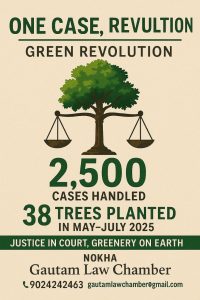One Case, One Tree – Green Revolution by Gautam Law Chamber
1. Vision & Mission
Vision:
To create a greener, cleaner, and healthier planet by linking every legal victory to environmental restoration.
Mission:
For every case handled by Gautam Law Chamber, one tree will be planted, maintained, and tracked to maturity — making legal advocacy a force for both justice and climate action.
2. Core Philosophy
- Justice & Nature Together: Legal systems deliver justice to people; this campaign extends that justice to nature.
• Measurable Impact: Every case = 1 planted tree = tangible environmental benefit.
• Public Accountability: Regular updates on plantations and tree survival rates build trust.
3. Strategic Objectives
- Environmental Impact: Plant & nurture trees across urban and rural areas.
2. Public Engagement: Turn clients, advocates, and law students into “Green Justice Ambassadors.”
3. Brand Positioning: Establish Gautam Law Chamber as a socially responsible, eco-conscious legal firm.
4. Campaign Phases
Phase 1 – Launch & Awareness:
– Press conference with Bar Association & media houses.
– Launch posters, banners, and social media handles for the campaign.
– Introduce #OneCaseOneTree as a recognisable hashtag.
Phase 2 – Action & Engagement:
– Tree Planting Drives with clients & community volunteers.
– Distribute Green Justice Certificates to clients.
– Encourage clients to join planting days.
Phase 3 – Tracking & Transparency:
– Digital plantation dashboard with stats and geo-tagged photos.
Phase 4 – Expansion & Partnerships:
– Partner with NGOs, municipal bodies, and environmental agencies.
– Court campus greening projects.
– Collaboration with law schools.
5. Key Branding Elements
- Logo: Tree merged with scales of justice.
• Color Palette: Dark Green, Earth Brown, Cream.
• Tagline: ‘Justice in Court, Greenery on Earth’ or ‘Verdicts for People, Roots for the Planet’.
6. Measurable Goals (First 3 Years)
Year 1: 2,500 trees planted, 70%+ survival rate.
Year 2: 5,000 total trees planted, 75%+ survival rate.
Year 3: 10,000 total trees planted, 80%+ survival rate.
7. Communication & Outreach
- Monthly Impact Reports on social media.
• Quarterly Press Releases with plantation statistics.
• Annual Green Justice Day: Celebrate milestones, invite media, felicitate contributors.
8. Signature Activities
- Tree per Case Program.
2. Green Pledge Signings.
3. Adopt-a-Tree Scheme.
4. Court Corridor Campaigns.
9. Long-Term Legacy
Within 10 years, Gautam Law Chamber could be credited with planting 50,000+ trees, offsetting thousands of tons of CO₂, and creating green cover equivalent to several city parks — turning a legal practice into a recognised environmental legacy.
10. Budget & Resource Allocation
Estimated Year 1 Budget:
– Saplings Purchase: ₹150,000 (2,500 saplings @ ₹60 each)
– Plantation & Maintenance: ₹200,000 (labour, watering, fencing)
– Awareness Materials: ₹75,000 (posters, banners, certificates)
– Event Costs: ₹100,000 (launch, plantation drives, Green Justice Day)
– Digital Infrastructure: ₹50,000 (website updates, dashboard)
Total: ₹575,000
Funding Sources:
– Gautam Law Chamber CSR funds
– Client contributions
– NGO & Corporate sponsorships
11. Timeline (Year 1)
Q1: Campaign launch, press release, first plantation drive.
Q2: Digital dashboard live, 1,000 trees planted.
Q3: School & college awareness programs, additional 800 trees.
Q4: Annual Green Justice Day, final 700 trees planted, yearly impact report.
12. Key Stakeholders
- Gautam Law Chamber management & staff.
• Clients and their families.
• Local Bar Associations.
• Environmental NGOs.
• Municipal & State Government bodies.
• Law students & volunteers.
13. Risk Management
- Tree Survival Risk: Partner with expert NGOs to ensure >70% survival rate.
• Funding Gaps: Maintain multiple funding channels.
• Public Engagement Drop: Regularly release impact stories to keep interest alive.
• Land Availability Issues: Pre-arrange planting sites with municipal and forest departments.
14. Impact Metrics & Evaluati on
on
- Number of trees planted per case.
• Tree survival rates after 1 year.
• Estimated CO₂ absorption annually.
• Number of clients engaged in plantation drives.
• Media coverage & social media reach.
• Community benefits (shade, fruit, biodiversity improvement).